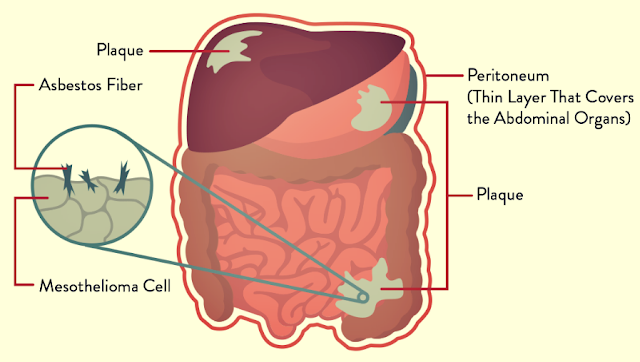Peritoneal Mesothelioma
Peritoneal mesothelioma is a type of cancer that influences the covering of the mid-region (the peritoneum). It is caused by the ingestion of asbestos fibers.

Peritoneal mesothelioma represents 20 to 25 percent of all mesothelioma cases. It is the most widely recognized diagnosis of pleural mesothelioma. Peritoneal patients have longer life expectancies than those with different types of mesothelioma. A few investigations report patients living upwards of 5 years after cytoreductive surgery.
Cytoreductive Surgery
This is the main surgical choice accessible to those with a peritoneal diagnosis. This surgery has high achievement rates when it is joined with chemotherapy.
Chemotherapy
This is the most well-known treatment for peritoneal mesothelioma. It is infrequently managed specifically to the stomach area amid surgery.
Radiation
This is the minimum intrusive treatment choice for peritoneal mesothelioma patients. Radiation might be conveyed amid surgery too.
A patient with peritoneal mesothelioma may not encounter symptoms at an early stage. In the event that symptoms are clear, they might be confused for different ailments. One regular side effect in numerous peritoneal mesothelioma patients is liquid pockets called ascites, which frequently make the stomach district swell outward. Different symptoms include:
Like pleural mesothelioma, peritoneal mesothelioma is most regular in guys between the ages of 50-69 years of age. Men who have the most astounding rates of peritoneal mesothelioma are veterans and those with the word related presentation to asbestos.
Peritoneal mesothelioma does not typically spread to the lymphatic framework (lymph hubs) or circulation system. It normally metastasizes in substantial masses in similar zones where it began.
1 .Asbestos fibers are ingested. This can occur subsequent to being breathed in, hacked up, and after that gulped.
2 .The body endeavors to channel and expel them, however, the sharp fibers can hold up into the coating of the stomach area (peritoneum). The fibers aggravate the peritoneum and can make hereditary harm cells.
3 .Hereditary harm can shield cells from accepting critical flags about when to quit imitating. This causes unchecked cell division and the arrangement of a dangerous tumor. It can take a long time for this procedure to happen.
CT outputs or MRI test results may not demonstrate the nearness of mesothelioma. It is regularly mistaken for stomach distension (gas). X-beams are the most generally utilized imaging instrument to analyze peritoneal mesothelioma.
Specialists may likewise utilize a strategy called peritoneoscopy. Amid this methodology, a specialist makes a little cut on the patient's stomach area and utilizations a little camera to investigate the belly. There is additionally an instrument on the camera that concentrates tissue on the peritoneum to test for mesothelioma.
Specialists don't utilize a standard organizing framework when diagnosing peritoneal mesothelioma.
For the most part, before the tumors begin to spread, peritoneal mesothelioma is concentrated in the stomach area. As it advances to arrange 2, the mesothelioma may spread all the more yet is as yet contained in the peritoneum. In the last stage, arrange 4, the mesothelioma has spread to different organs, for example, the liver and colon.
Treatment choices are reliant on the stage a peritoneal mesothelioma persistent is determined to have. There are more therapeutic treatment alternatives, similar to cytoreduction surgery, for patients with prior stages.
Patients in the later stages may get palliative treatments, similar to radiation or chemotherapy. Another palliative treatment alternative might be a paracentesis to deplete the liquid development in the guts.
The best treatment of peritoneal mesothelioma has been the blend of cytoreduction surgery and HIPEC (warmed intraperitoneal chemotherapy). The cytoreduction evacuates the vast majority of the cancerous tumor, and HIPEC is utilized to murder the rest of the cells.
This treatment has been fruitful in patients with great general wellbeing. A few patients have lived as long as 7 years in the wake of having this surgery.
In spite of the fact that there isn't at present a cure for peritoneal mesothelioma, numerous patients have a confident visualization. The middle survival time for patients who have not had the cytoreductive surgery is about a year; in any case, in patients who have had the surgery, survival times increment by up to five years. There have been instances of long-haul survivors who have been going away for more than fifteen years. The best cases are those whose mesothelioma is identified in the before stages and start treatment instantly. A large portion of postulations cases incorporates a cytoreductive surgery and HIPEC.
What is Peritoneal Mesothelioma?

Peritoneal mesothelioma represents 20 to 25 percent of all mesothelioma cases. It is the most widely recognized diagnosis of pleural mesothelioma. Peritoneal patients have longer life expectancies than those with different types of mesothelioma. A few investigations report patients living upwards of 5 years after cytoreductive surgery.
How Is Peritoneal Mesothelioma Treated?
Cytoreductive Surgery
This is the main surgical choice accessible to those with a peritoneal diagnosis. This surgery has high achievement rates when it is joined with chemotherapy.
Chemotherapy
This is the most well-known treatment for peritoneal mesothelioma. It is infrequently managed specifically to the stomach area amid surgery.
Radiation
This is the minimum intrusive treatment choice for peritoneal mesothelioma patients. Radiation might be conveyed amid surgery too.
Symptoms
A patient with peritoneal mesothelioma may not encounter symptoms at an early stage. In the event that symptoms are clear, they might be confused for different ailments. One regular side effect in numerous peritoneal mesothelioma patients is liquid pockets called ascites, which frequently make the stomach district swell outward. Different symptoms include:
- Stomach Pain
- Loss of Appetite
- Blood Clots
- Exhaustion
- Liquid Buildup (Ascites)
- Sickness
- Stomach Swelling
- Fever or Sweating
- Tissue Lumps in the Abdomen
- Weakness
- Seizures
- Entrail Problems
Causes
Like pleural mesothelioma, peritoneal mesothelioma is most regular in guys between the ages of 50-69 years of age. Men who have the most astounding rates of peritoneal mesothelioma are veterans and those with the word related presentation to asbestos.
Peritoneal mesothelioma does not typically spread to the lymphatic framework (lymph hubs) or circulation system. It normally metastasizes in substantial masses in similar zones where it began.
How Does Peritoneal Mesothelioma Develop?
1 .Asbestos fibers are ingested. This can occur subsequent to being breathed in, hacked up, and after that gulped.
2 .The body endeavors to channel and expel them, however, the sharp fibers can hold up into the coating of the stomach area (peritoneum). The fibers aggravate the peritoneum and can make hereditary harm cells.
3 .Hereditary harm can shield cells from accepting critical flags about when to quit imitating. This causes unchecked cell division and the arrangement of a dangerous tumor. It can take a long time for this procedure to happen.
Diagnosis
CT outputs or MRI test results may not demonstrate the nearness of mesothelioma. It is regularly mistaken for stomach distension (gas). X-beams are the most generally utilized imaging instrument to analyze peritoneal mesothelioma.
Specialists may likewise utilize a strategy called peritoneoscopy. Amid this methodology, a specialist makes a little cut on the patient's stomach area and utilizations a little camera to investigate the belly. There is additionally an instrument on the camera that concentrates tissue on the peritoneum to test for mesothelioma.
Specialists don't utilize a standard organizing framework when diagnosing peritoneal mesothelioma.
For the most part, before the tumors begin to spread, peritoneal mesothelioma is concentrated in the stomach area. As it advances to arrange 2, the mesothelioma may spread all the more yet is as yet contained in the peritoneum. In the last stage, arrange 4, the mesothelioma has spread to different organs, for example, the liver and colon.
Treatment
Treatment choices are reliant on the stage a peritoneal mesothelioma persistent is determined to have. There are more therapeutic treatment alternatives, similar to cytoreduction surgery, for patients with prior stages.
Patients in the later stages may get palliative treatments, similar to radiation or chemotherapy. Another palliative treatment alternative might be a paracentesis to deplete the liquid development in the guts.
The best treatment of peritoneal mesothelioma has been the blend of cytoreduction surgery and HIPEC (warmed intraperitoneal chemotherapy). The cytoreduction evacuates the vast majority of the cancerous tumor, and HIPEC is utilized to murder the rest of the cells.
This treatment has been fruitful in patients with great general wellbeing. A few patients have lived as long as 7 years in the wake of having this surgery.
Anticipation
In spite of the fact that there isn't at present a cure for peritoneal mesothelioma, numerous patients have a confident visualization. The middle survival time for patients who have not had the cytoreductive surgery is about a year; in any case, in patients who have had the surgery, survival times increment by up to five years. There have been instances of long-haul survivors who have been going away for more than fifteen years. The best cases are those whose mesothelioma is identified in the before stages and start treatment instantly. A large portion of postulations cases incorporates a cytoreductive surgery and HIPEC.





